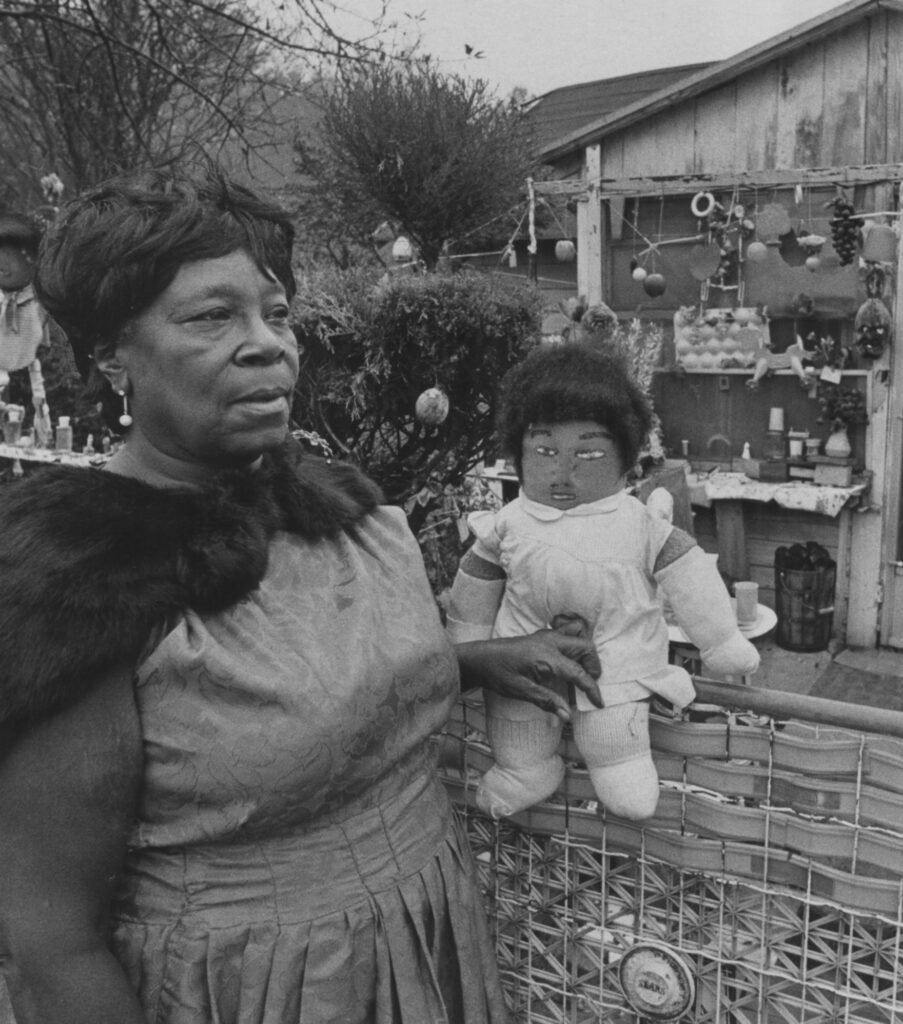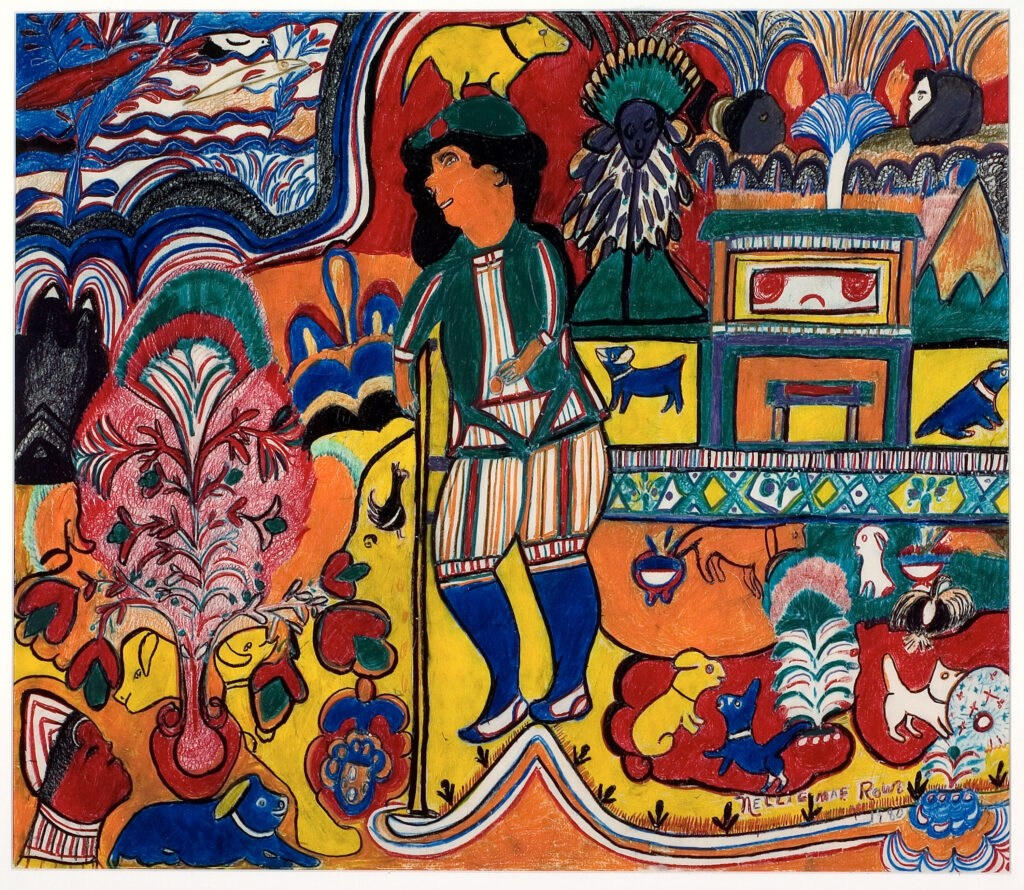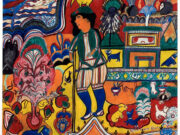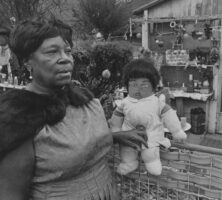A creative and resourceful self-taught artist, Nellie Mae Rowe gained national recognition for her work during the last decade of her life. Long before her wider success, Rowe was well known locally in Vinings by visitors who came to her exuberantly embellished home, which contained her drawings, stuffed dolls, and recycled objects.
After the death of her second husband, Rowe turned their home into her personal playhouse, decorating all available space, inside and out, with her fanciful creations. A devout Christian, she attributed her talent to God. Rowe’s multifaceted work illustrates her personal mythology, her response to current events and popular culture, and an assimilation of African American spiritual and narrative traditions.
The Formative Years
Born on July 4, 1900, in a Fayette County farming community twenty miles south of Atlanta, she was the ninth of ten children born to Luella Swanson and Sam Williams. Her father was born into slave status, and her mother was born after emancipation in 1864. Her father rented a farm and augmented the family income by working as a blacksmith and a basket weaver. Both parents were respected members of the community, Rowe’s father for his business sense and handicraft skills and Rowe’s mother for her expertise as a seamstress and quilter.

Rowe showed an early talent for drawing and doll making, endeavors she preferred to her work as a farmhand. The family attended Flat Rock African Methodist Episcopal Church, the oldest active congregation in the area. The fellowship hall, adjacent to the church, also housed the elementary school that the young artist attended for several years. In 1916 she married Ben Wheat. Fourteen years later, the couple moved to Vinings, a rural community northwest of Atlanta, in pursuit of better opportunities. Her husband died in 1936, and later that year she married Henry “Buddy” Rowe, a much older widower with three grown children. In 1937 the couple built their home on the main street in Vinings, just a few miles from the Georgia governor’s mansion, which is part of the Buckhead community. The Rowes would spend the rest of their lives in that house.
Recognition
When her second husband died in 1948, Rowe worked as a domestic and increased her artistic output. Free-spirited, independent, and childless, she was able to explore her creativity unencumbered by family obligations. Her home attracted attention, although not always positive, with its display of colorful drawings, stuffed dolls wearing wigs and glasses, hardened chewing-gum sculptures, garden topiary, plastic flowers, Christmas ornaments, and recycled objects. Visitors attracted to the highly decorated swept yard were welcome to tour the home and document their visit by signing a guest book. Rowe sang gospel songs to her guests, accompanying herself on electric organ, and basked in their attention. Among her visitors were artists and collectors who recognized her talent and succeeded in bringing her work to a wider audience.
The first exhibition to include Rowe’s work was Missing Pieces: Georgia Folk Art 1770–1976 at the Atlanta History Center in 1976. Shortly thereafter Judith Alexander, an Atlanta gallery owner, became her friend and art dealer, making sure Rowe had adequate art supplies and a stable income. Rowe’s first one-person exhibition was held in November 1978 at the Alexander Gallery in Atlanta. The following year Rowe took her first journey outside of Georgia to view her solo exhibition at the Parsons/Dreyfuss Gallery in New York City. National recognition was swift, and her work was subsequently included in numerous exhibitions as she entered her most prolific period of artistic creation.
In 1981 Rowe was diagnosed with cancer. She died on October 18, 1982, and is buried in the cemetery at Flat Rock African Methodist Episcopal Church in Fayetteville.
Artistic Style
Rowe’s distinctive style shows an intuitive sense of color and form. She preferred simple materials—crayons, markers, pencils, pens, paper, cardboard, egg cartons, and Styrofoam food trays—and enjoyed creating works of art from recycled objects by fashioning figures from chewing gum or dolls from fabric scraps. Trinkets, marbles, and plastic toys often embellish her work. Rowe also drew on or added collage elements to cast-off items to create new pieces of art. Unconcerned with perspective or scale, she carefully composed her vibrant and intricately patterned drawings through the use of color, giving her work a sense of depth and rhythm.
Although Rowe stressed that she was a devout Christian, such African and Afro-Caribbean symbolism as haints, charms, and protective signs are often found in her work. Texts, tracings of her hands and feet, African American cultural figures, images of personal friends, self-portraits, and fanciful creatures also populate her lush landscapes.

Rowe’s unorthodox view of life has left an indelible mark on the study of self-taught southern artists. Her work is included in numerous private and public collections, including the Morris Museum of Art in Augusta, the High Museum of Art in Atlanta, the Smithsonian American Art Museum and the Library of Congress American Folklife Center in Washington, D.C., and the American Folk Art Museum in New York. Rowe’s crayon work The Hiker (1980) is part of Georgia’s State Art Collection.








